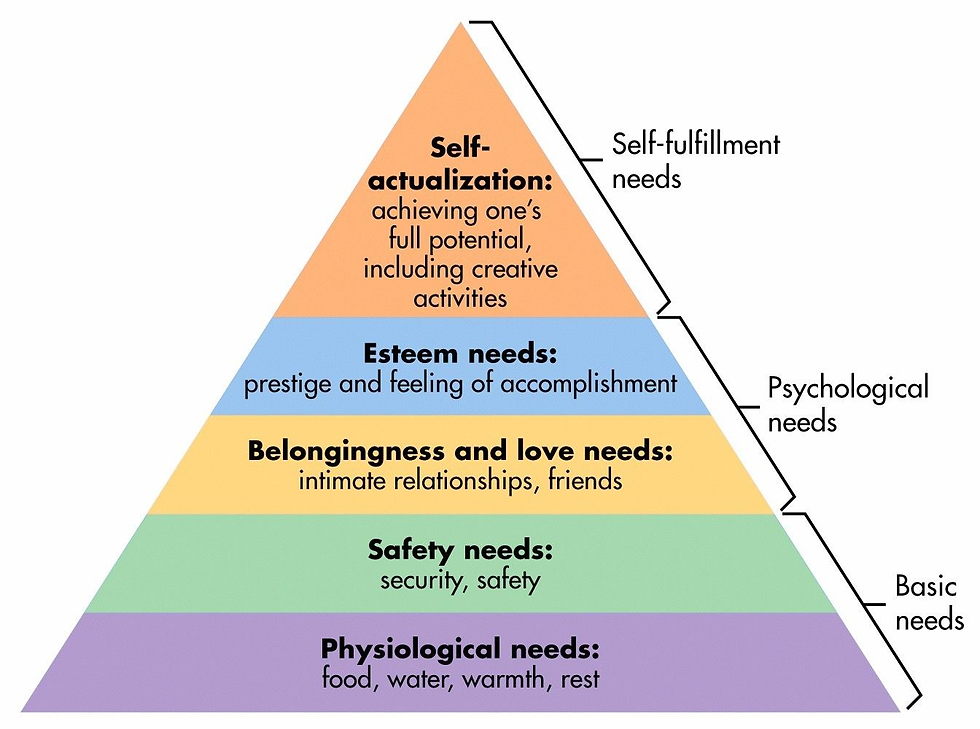Why Educational Equity Needs a Closet
- Jaci Fong
- Dec 5, 2022
- 3 min read
Updated: Jan 15, 2023
January 15, 2023

McLeod, S. A. (2022, April 04). Maslow's hierarchy of needs. Simply Psychology.www.simplypsychology.org/maslow.html
If you have ever attended a college education class you have heard of Maslow's Hierarchy of Needs. This pyramid is often discussed because it reminds teachers that in order to learn a person’s basic needs must be met first. The lowest level of the pyramid identifies food, water, warmth, rest and physical safety as one’s basic needs.
Enclothed Cognition, the clothes we wear affect our behavior, attitudes, personality, mood, confidence, and the way we interact with others, is a real thing.
Having identified their direct impact on learning, the federal government has invested billions of dollars in school funding to help schools access these resources for students. We see examples of this through free and reduced cost lunch programs and increased access to safety equipment for schools. One area that has limited resources is clothing.
Since it is not directly highlighted on Maslow’s pyramid why should schools invest in clothing resources for their students?
Because Enclothed Cognition, the clothes we wear affect our behavior, attitudes, personality, mood, confidence, and the way we interact with others, is a real thing. No one knows this better than school aged children.
Think how powerful it is when you feel good in an outfit you’re wearing! Your shoulders are back and your chin is high ready to take on anything. Putting on an outfit where you feel uncomfortable immediately reduces your self confidence causing some level of anxiety for the rest of the day.
A child's ability to fit in and be accepted by their peers directly affects their academic success. A study done in older students demonstrated that the more the student felt a part of their community was a direct correlation to higher grade point average. Being a part of the greater community helps you feel safe and secure which Maslow reminds us is one of our basic needs.
Students are at risk of academic loss and decrease in overall grades when they are singled out for clothing related reasons such as;
Infrequently washed clothing
Out-dated clothing
Hand-me-down or worn clothing
Ill fitting clothing
Wearing the same clothing repeatedly
Inappropriate clothing for the setting (ie, gym clothes, concert attire, formal wear)
Children with these clothing issues are prime targets for bullying.
According to the US Census Bureau, 11.6 million children are living in poverty in the United States which equates to 1 in 7 students. In every classroom in America there are children with clothing issues hoping to just get through the day. This constant anxiety reduces a student’s ability to listen and retain information thus lowering their ability for academic success. Additionally, increases in student absence rates have been seen to be directly correlated to access to the “right” clothing.
Investing in clothing can help increase equity in learning and increase children’s ability to rise ¹above poverty. Many schools are creating discrete clothing closets with current fashions and opportunities for students in need to access the clothing they deserve. This is often done without additional funding, space, or staff to adequately implement to meet the demands. An increase in clothing resources for schools will contribute to higher national test scores, increased children’s mental health, and educational equity.
References:
Adam, H., & Galinsky, A. D. (2012). Enclothed cognition. Journal of Experimental Social Psychology, 48(4), 918–925. https://doi.org/10.1016/j.jesp.2012.02.008
American Academy of Pediatrics (2022, September 16). School Attendance, Truancy & Chronic Absenteeism: What Parents Need to Know. Healthychildren.org. Retrieved January 13, 2022, from https://www.healthychildren.org/English/ages-stages/gradeschool/school/Pages/School-Attendance-Truancy-Chronic-Absenteeism.aspx?_ga=2.84617424.814995987.1673629183-1642380552.1673629181&_gl=1*ujt7fl*_ga*MTY0MjM4MDU1Mi4xNjczNjI5MTgx*_ga_FD9D3XZVQQ*MTY3MzYyOTE4NC4xLjAuMTY3MzYyOTE4NC4wLjAuMA..
Creamer, J. (2022, September 13). Poverty in the United States: 2021. Census.gov. Retrieved January 13, 2023, from https://www.census.gov/library/publications/2022/demo/p60-277.html
Greenaway, K., Amiot, C.E., Louis, W. R., & Bentley, S.V. (2017). The role of psychological need satisfaction in promoting student identification. In K. I. Mavor, M. Platow, & B. Bizumic (Eds.), Self and Social Identity in Educational Contexts, pp. 176-192. Routledge : New York, USA.




Comments